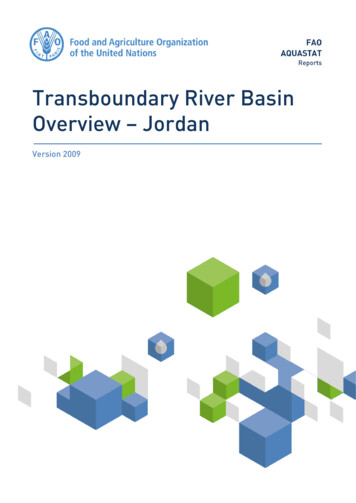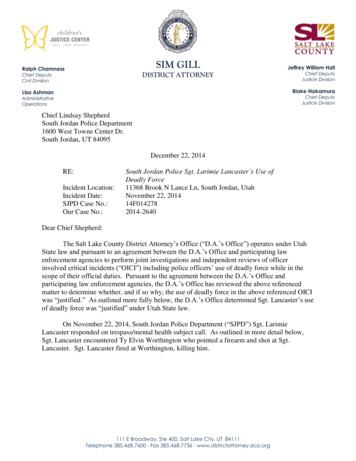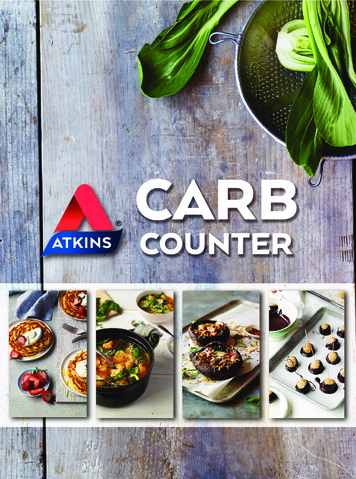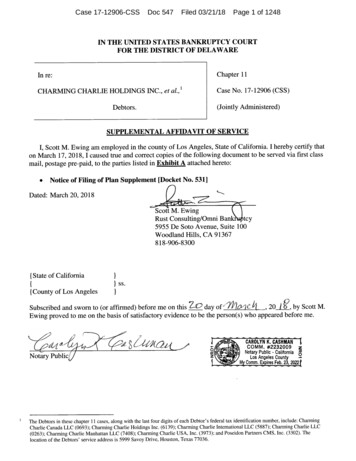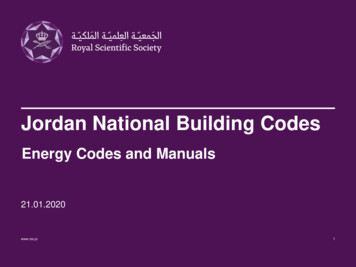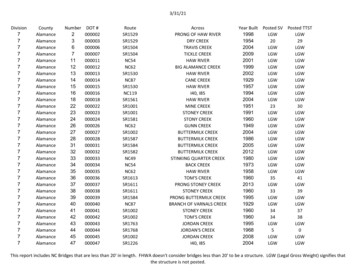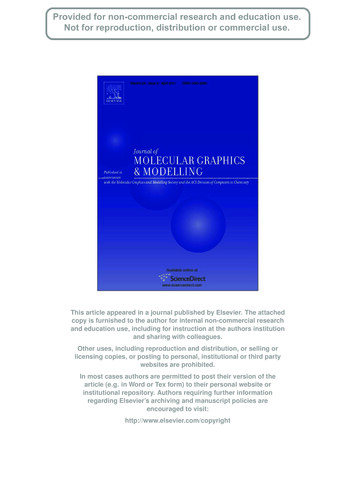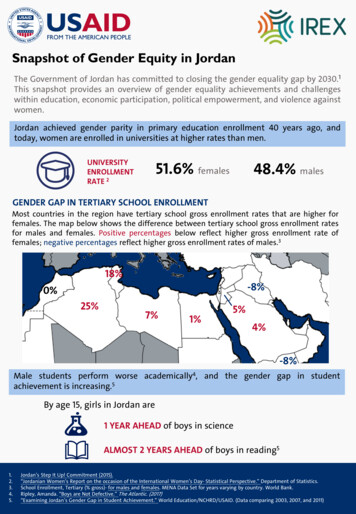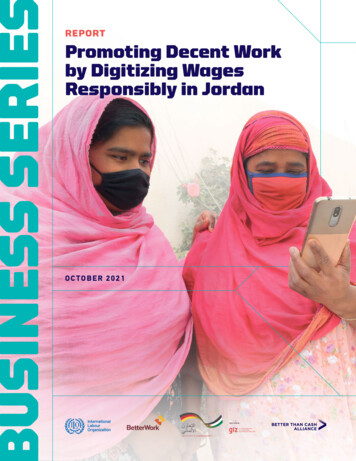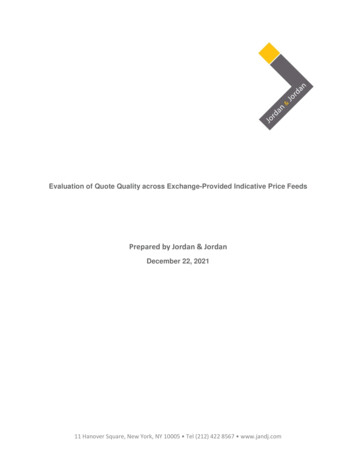
Transcription
Evaluation of Quote Quality across Exchange-Provided Indicative Price FeedsPrepared by Jordan & JordanDecember 22, 202111 Hanover Square, New York, NY 10005 Tel (212) 422 8567 www.jandj.com
Table of Contents1.Introduction . 32.Data . 43.Methodology. 64.NBBO Results Summary . 75.Pre-Market: 9:15 to 9:30. 96.Quote Analysis Results by Category. 116.1All NMS Securities . 116.2Tape A . 136.3Tape B . 156.4Tape C. 176.5ETPs . 196.6Preferred Stocks . 216.7High Volume - Above 1MM Shares Traded Daily . 236.8Excluding High-Volume - Below 1MM Shares Traded Daily. 256.9Low Volume - Below 50,000 Shares Traded Daily . 276.10Very Low Volume - Below 10,000 Shares Traded Daily . 29Appendix A: Time-weighted NBBO metrics . 31Appendix B: Time-weighted display size metrics. 332
1. IntroductionNasdaq Basic, NYSE BQT and Cboe One are proprietary consolidated market data feeds that provide aunified view of comprehensive last sale and Best Bid and Offer (“BBO”) in all Tape A, B, and C securitiesthat trade across each of those exchange groups. They are not intended to be used for purposes ofmaking order-routing or trading decisions, but rather provide indicative prices for NMS stocks. Theexchange-provided indicative data feeds distribute on a real-time basis the same BBO information thattheir respective exchanges provide to the CTA/UTP Securities Information Processors (“SIP”), whichdisseminates the BBOs and last trades for NMS Stocks from all U.S. equities markets and calculates theNational Best Bid or Offer (“NBBO”).The NYSE BQT data feed provides best bid and offer and last sale information using the combined datafrom the New York Stock Exchange LLC (“NYSE”) and its affiliates, NYSE Arca, Inc. (“NYSE Arca”), NYSEAmerican LLC (“NYSE American”), NYSE National, Inc. (“NYSE National”) and NYSE Chicago, Inc. (“NYSEChicago”). NYSE BQT also includes trades reported to the FINRA/NYSE Trade Reporting Facility (“TRF”).The Cboe One Feed provides best bid and offer and last sale information using the combined data of thefour Cboe U.S. equities exchanges, Cboe BZX Exchange, Inc. (“BZX”), Cboe BYX Exchange, Inc. (“BYX”),Cboe EDGX Exchange, Inc. (“EDGX”), and Cboe EDGA Exchange, Inc. (“EDGA”). Nasdaq Basic providesbest bid and offer and last sale information based on data from the Nasdaq Stock Market LLC (“Nasdaq”)and also trades reported to the FINRA/Nasdaq TRFs. (Nasdaq Basic does not include Nasdaq BX, Inc.(“Boston”) and Nasdaq PHLX LLC (“PSX”) as part of its base package. Quotes from those exchanges arenot included in the composition of Nasdaq Basic in our analysis.)Here we present the results of a comparative study which was conducted to assess the quality of thethree exchange-provided indicative data feeds; where quality is expressed as a measure of thepercentage of time in which quotes from an exchange-provided indicative data feed are the same as theNBBO or within various thresholds of the NBBO. The study was conducted using SIP data collected fromJune 2021.11NYSE Group provided financial support for this study.3
2. DataThe data used in our analysis was sourced from NYSE Daily TAQ for the month of June 2021. NYSE DailyTAQ provides trades and top-of-book quotes from all NMS Stocks for all equities markets timestampedto the nanosecond and is sourced from SIP data. As of June 2021, there were 16 national stockexchanges in operation. There were 22 days in June on which these markets were open.The dataset includes roughly 10,712 securities. This count varies from day to day as additional securitiesare listed and some are delisted. For example, on June 1, 2021, the dataset consisted of 10,712securities of which 2,458 were ETPs (including exchange traded funds, notes and vehicles) and 558 werepreferred stock. Of the total number of securities, 3,585 have their trades printed to Tape A, 2,420 toTape B and 4,707 to Tape C.In addition to these categories, securities can be grouped according to their trading volumes. We usefour groups: (1) “High Volume”, where greater than 1,000,000 shares are traded daily; (2) “ExcludingHigh-Volume”, where less than 1,000,000 shares are traded daily; (3) “Low Volume”, where less than50,000 shares are traded daily; and (4) “Very-Low Volume”, where less than 10,000 shares are tradeddaily. Note that group 1 and group 2 are mutually exclusive, while group 3 is a subset of group 2 andgroup 4 is a subset of group 3.On June 1, 2021, there were 1,932 High-Volume securities, 8,783 securities not considered HighVolume, 4,391 Low-Volume securities and 2,670 Very-Low-Volume securities. Note that since a symbol’strading volume changes from day to day, a symbol’s classification with respect to a volume range mayalso change. The following table illustrates how the number of securities in these categories changedfrom the first to the last trading day of June 2021. These counts do not include test symbols.CategoryAllTape ATape BTape CETPPreferred(1) Vol 1MM(2) Vol 1MM(3) Vol 50K(4) Vol 10KJune June 4Table 1: Number of Securities per Category.Quotes for the three exchange-provided indicative data feeds were derived from the quotes of theirconstituent exchanges by comparing the bid/ask prices after each quote event. Among these top-of4
book quotes, the quote with the best bid price was selected for the feed’s bid price and size, and thequote with the best ask price was selected as the feed’s ask price and size.When comparing an exchange-provided indicative data feed to the NBBO, we considered all eligiblesecurities, regardless of whether an exchange or indicative feed produced a quote on a given day forthat security. If an exchange or indicative feed does not quote an eligible security, then its average timewithin various thresholds of the NBBO, including "at" the NBBO, will be 0 for that day.5
3. MethodologyTo compare exchange-provided indicative data feed products to one another, we assessed their quotequality with respect to the prevailing NBBO. Several metrics were calculated that express both thepercentage of time and size of a feed’s quote, within various thresholds of the NBBO.We define the term “within a threshold of X percent of the NBBO” for a quote as the condition wherethe quote’s bid price differs from the national best bid (NBB) by no more than X percent and, at thesame time, its ask price differs from the national best offer (NBO) by no more than X percent. When thethreshold is zero on both sides the quote is said to be “at” the NBBO.Using this definition, time-weighted averages, representing the percentage of time one can expect anyquote to be within the NBBO, were calculated for each of the three exchange-provided indicative datafeed products. Similar time-weighted averages were calculated for each of the constituent exchanges ofthe data feed products.The time-weighted averages for each covered security were calculated over the twenty-two consecutivetrading days from Tuesday, June 1, 2021, through Wednesday, June 30, 2021. Quotes occurring frommarket open, 9:30 am, until market close, 4:00 pm, were considered in the analysis, with the mostrecent quote prior to the open given a timestamp of 9:30 am to set the prevailing quote at the open. Inaddition, time intervals in which no NBBO had been established by the SIP, as in the case where bothNBB and NBO are zero, were not included.NYSE Daily TAQ data, as previously described, was obtained for this period, and was used in the analysis.All timestamps from the TAQ data were represented in nanoseconds and were not rounded during theanalysis. Thresholds of 0.1%, 0.25%, 0.5%, and 1.0% were used to calculate the averages. (In absoluteterms, these thresholds are 5 cents, 12.5 cents, 25 cents, and 50 cents, respectively, for a stock tradingat 50 a share.) Averages were calculated for each symbol, date, feed combination for benchmarkingto the NBBO.Time-weighted average display sizes at the NBBO for each exchange-provided indicative data feed werecalculated by taking the sum of the display sizes of each constituent exchange quote with a price at theNBBO. For example, at a given time if the bid price for a 300-share quote from EDGA and the bid pricefor a 200-share quote from EDGX both were equal to the NBB, and quotes from BYX and BZX had bidprices lower than NBB, then the display size at the NBB for the CBOE One indicative feed quote would be500 shares.Symbols were grouped by security type (Preferred or ETP), tape (A, B, or C)2, and ranges of daily volume(greater than 1,000,000 shares, less than 50,000 shares and less than 10,000 shares). Separate resultswere obtained for each category by applying an equal weight to the calculated averages of the symbolswithin the specific group.2Tape A represents all NYSE-listed securities, Tape B represents all stocks listed on NYSE American, NYSE Arca andCBOE BZX, and Tape C represents all stocks listed on Nasdaq.6
4. NBBO Results SummaryTo highlight the general differences between the exchange-provided indicative data feeds, the followingchart is presented. It compares the average percent of time in which quotes from each of the threeindicative feeds were at the NBBO for each of the security categories during market hours (9:30 am to4:00 pm).Figure 1: Percentage of time quotes are at the NBBO by security category.7
The time-weighted average number of shares displayed when the quote is at the NBBO was alsocalculated.Security CategoryALLTape ATape BTape CETPPref(1) Vol 1MM(2) Vol 1MM(3) Vol 50K(4) Vol 10KNYSE BQT1,5721,5943,0368043,2175134,992923839926CBOE One1,1458052,2618292,4482003,212753695766Nasdaq Basic9515741,3071,0521,5691582,768606591652Table 2: Time-weighted average display size at the NBBO.33A 99.5% winsorization was applied to shares displayed at the NBBO to reduce the effect of outliers, resulting in amore accurate picture of liquidity available on each market.8
5. Pre-Market: 9:15 am to 9:30 amIn addition to the quote analysis performed on quotes during market hours, we also performed similaranalysis for the fifteen minutes prior to the opening of the markets.4The following chart presents the average percent of time in which quotes from each of the threeexchange-provided indicative data feeds were at the NBBO for each of the security categories from 9:15am until 9:30 am.Figure 2: Pre-open percentage of time quotes are at the NBBO by security category.When broken down by feed and exchange in the fifteen minutes before the open, we find that theNBBO is driven by only a small number of exchanges; in particular, NYSE Arca, BZX, EDGX, and Nasdaq.This is illustrated in figure 3 which follows.4NYSE does not quote Tape A securities prior to 9:30 am.9
Figure 3: Pre-open percentage of time quotes are at the NBBO by feed/exchange.10
6. Quote Analysis Results by CategoryResults for the various groups of securities are presented in the sections that follow. Each will show (1)the average percent of time quotes are at the NBBO for each exchange-provided indicative data feedproduct and individual exchanges (Long-Term Stock Exchange, Inc. is not shown), (2) changes in the timepercentages as the threshold from the NBBO is increased from 0 to 1%, and (3) the count of securities inwhich their calculated average percent of time at the NBBO is above 90%, 80%, and down to 0%.6.1All NMS SecuritiesFigure 4: Percentage of time All NMS quotes are at the NBBO by feed/exchange.The preceding chart presents the average percent of time quotes are at the NBBO for each exchangeprovided indicative data feed product and their constituent exchanges for all NMS stocks.11
The preceding figure illustrates the average percentage of time the exchange-provided indicative datafeeds for all NMS Stocks are at or within thresholds of 0.1%, 0.25%, 0.50%, and 1%. (In absolute terms,these thresholds are 5 cents, 12.5 cents, 25 cents, and 50 cents, respectively, for a stock trading at 50 ashare.) As the amount of the threshold increases so too does the average percentage of time theexchange-provided indicative data feeds are within the threshold.The number of NMS securities meeting thresholds of 90% of the time at the NBBO, down to 10% of thetime at the NBBO are provided in the following table.Security count at NBBO 90% of time 80% of time 70% of time 60% of time 50% of time 40% of time 30% of time 20% of time 10% of time 0% of timeNYSE ,749CBOE ,749Nasdaq 10,749Table 3: Number of NMS securities meeting percent of time thresholds.12
6.2Tape ALooking at the average percent of time quotes are at the NBBO for each exchange-provided indicativedata feed product and their constituent exchanges for Tape A (NYSE listed) stocks as we would expectNYSE BQT and its constituent exchanges perform significantly better than the other exchange-providedindicative data feed products and their constituent exchanges.Similarly, the average percentage of time NYSE BQT is within thresholds of 0.1%, 0.25%, 0.50%, and 1%of the NBBO in all cases is higher than the other exchange-provided indicative data feed products, withNasdaq Basic having the lowest average percentage of time within the thresholds.Figure 5: Percentage of time Tape A quotes are at the NBBO by feed/exchange.13
Tape A securities at NBBO 90% of time 80% of time 70% of time 60% of time 50% of time 40% of time 30% of time 20% of time 10% of time 0% of timeNYSE 578CBOE q le 4: Number of Tape A securities meeting percent of time thresholds.14
6.3Tape BFor Tape B (NYSE American, NYSE Arca, BZX listed) stocks, NYSE BQT continues to outperform the otherexchange-provided indicative data feed products and their constituent exchanges in terms of theaverage percentage of time at the NBBO or within thresholds of 0.1%, 0.25%, 0.50%, and 1% of theNBBO.Figure 6: Percentage of time Tape B quotes are at the NBBO by feed/exchange.15
Tape B securities at NBBO 90% of time 80% of time 70% of time 60% of time 50% of time 40% of time 30% of time 20% of time 10% of time 0% of timeNYSE 433CBOE asdaq Basic3735286677999211,0341,1441,2651,4152,433Table 5: Number of Tape B securities meeting percent of time thresholds.16
6.4Tape CThe following figure illustrates the average percent of time quotes are at the NBBO for each exchangeprovided indicative data feed product and their constituent exchanges for Tape C (Nasdaq listed) stocksand as we would expect Nasdaq Basic statistically outperforms the other exchange-provided indicativedata feed products and their constituent exchanges.Figure 7: Percentage of time Tape C quotes are at the NBBO by feed/exchange.The disparity in the average percentage of time Nasdaq Basic is within thresholds of the NBBO begins toconverge with CBOE One at 0.50% threshold of the NBBO.17
Tape C securities at NBBO 90% of time 80% of time 70% of time 60% of time 50% of time 40% of time 30% of time 20% of time 10% of time 0% of timeNYSE BQT3324866267679311,1431,4471,9322,7764,737CBOE daq 737Table 6: Number of Tape C securities meeting percent of time thresholds.18
6.5ETPsFor ETPs, NYSE BQT performs better than the other exchange-provided indicative data feed productslargely due to quotes from NYSE Arca.Figure 8: Percentage of time ETP quotes are at the NBBO by feed/exchange.The disparity in the average percentage of time NYSE BQT is within thresholds of the NBBO begins toconverge with CBOE One at 0.50% threshold of the NBBO.19
ETPs at NBBO 90% of time 80% of time 70% of time 60% of time 50% of time 40% of time 30% of time 20% of time 10% of time 0% of timeNYSE 474CBOE asdaq able 7: Number of ETP securities meeting percent of time thresholds.20
6.6Preferred StocksFigure 9: Percentage of time Preferred quotes are at the NBBO by feed/exchange.The preceding figure illustrates the average percent of time quotes are at the NBBO for each exchangeprovided indicative data feed product and their constituent exchanges for Preferred shares and NYSEBQT statistically outperforms the other exchange-provided indicative data feed products and theirconstituent exchanges.21
The disparity in the average percentage of time NYSE BQT is within thresholds of the NBBO incomparison to the other exchange-provided indicative data feed products begins to converge with CBOEOne at 0.50 threshold of the NBBO. Note that there is a significant jump in CBOE One as the threshold isincreased from 0.25% to 0.5%.Preferred Stocks at NBBO 90% of time 80% of time 70% of time 60% of time 50% of time 40% of time 30% of time 20% of time 10% of time 0% of timeNYSE BQT171268328365394414432448464556CBOE One481320304569106165556Nasdaq Basic243749627490111136182556Table 8: Number of Preferred securities meeting percent of time thresholds.22
6.7High Volume - Above 1MM Shares Traded DailyFor High Volume securities, where greater than 1,000,000 shares are traded daily, the average percentof time quotes are at the NBBO for each exchange-provided indicative data feed product and theirconstituent exchanges increases in comparison to the data for all NMS stocks.Figure 10: Percentage of time quotes for High-Volume securities are at the NBBO by feed/exchange.Similarly, the average percentage of time the exchange-provided indicative data feeds for all HighVolume securities are at NBBO or within thresholds of 0.1%, 0.25%, 0.50%, and 1% all increases relativeto the data for all NMS stocks.23
High Vol Stocks at NBBO 90% of time 80% of time 70% of time 60% of time 50% of time 40% of time 30% of time 20% of time 10% of time 0% of timeNYSE E q 5Table 9: Number of High-Volume securities meeting percent of time thresholds.24
6.8Excluding High Volume - Below 1MM Shares Traded DailyWhen the volumes decrease, we can see the quote quality begins to diminish. As can be seen in thefollowing chart, average percentage of time at the NBBO is lower for each feed for stocks with volumeless than 1MM daily shares than stocks with volumes greater than 1MM daily shares.It can also be noticed that the improvement in quote quality for this group does not increase as fast as itdid for the high-volume group.Figure 11: Percentage of time quotes for Non-High-Volume securities are at the NBBO by feed/exchange.25
Vol 1MM Stocks at NBBO 90% of time 80% of time 70% of time 60% of time 50% of time 40% of time 30% of time 20% of time 10% of time 0% of timeNYSE 034CBOE 4Nasdaq 9,034Table 10: Number of securities with vol 1MM meeting percent of time thresholds.26
6.9Low Volume - Below 50,000 Shares Traded DailyFigure 12: Percentage of time quotes for Low Volume securities are at the NBBO by feed/exchange.NYSE BQT continues to outperform the other exchange-provided indicative data feed products and theirconstituent exchanges in the average percent of time quotes are at the NBBO for Low Volume stocks,where less than 50,000 shares are traded daily.27
The average percentage of time Nasdaq Basic is within thresholds of 0.50% and 1% of the NBBO lags theother exchange-provided indicative data feed products. A steady increase is seen in NYSE BQT and anincrease in CBOE One is seen again at 0.50%.Vol 50K count at NBBO 90% of time 80% of time 70% of time 60% of time 50% of time 40% of time 30% of time 20% of time 10% of time 0% of timeNYSE 662CBOE daq 2Table 11: Number of Low Volume securities meeting percent of time thresholds.28
6.10Very Low Volume - Below 10,000 Shares Traded DailyFigure 13: Percentage of time quotes for Very Low Volume securities are at the NBBO by feed/exchange.In analyzing the average percent of time quotes are at the NBBO for each exchange-provided indicativedata feed product and their constituent exchanges for Very Low Volume securities, NYSE BQT performsbetter than the other exchange-provided indicative data feed product and constituent exchanges.However, as the thresholds of NBBO increase to 1% CBOE One average percentage of time within thethreshold of 1% is greater than NYSE BQT.29
Vol 10K count at NBBO 90% of time 80% of time 70% of time 60% of time 50% of time 40% of time 30% of time 20% of time 10% of time 0% of timeNYSE 5CBOE One4005186096857598389241,0261,1642,675Nasdaq le 12: Number of Very Low Volume securities meeting percent of time thresholds.30
Appendix A: Time-weighted NBBO metricsThe following table shows the calculated average amount of time quotes are within threshold of 0 (“At”), 0.1, 0.25, 0.5 and 1% of NBBO for eachsecurity category and for each indicative feed and constituent .917.017.493.265.406.347.407.864.4311 Hanover Square, New York, NY 10005 Tel (212) 422 8567 00.000.000.000.00
4730.6943.21Security CategoriesAll:HV:A:B:C:All NMS stocksHigh volume ( 1MM)Tape ATape BTape CETP:Pref:Low:VL:XHV:Exchange traded productsPreferred stocksLow volume ( 50K)Very low volume ( 10K)X-High-Volume ( 1MM)ExchangesA:B:C:H:J:K:L:M:NYSE American LLCNASDAQ BX, Inc.NYSE National, Inc.MIAX PEARL, LLCCboe EDGA Exchange, Inc.Cboe EDGX Exchange, Inc.Long-Term Stock Exchange, Inc.NYSE Chicago, Inc.N:P:Q:U:V:X:Y:Z:New York Stock Exchange LLCNYSE Arca, Inc.The Nasdaq Stock Market LLCMEMX LLCInvestors Exchange LLCNASDAQ PHLX LLCCboe BYX Exchange, Inc.Cboe BZX Exchange, 00.000.000.000.000.000.000.000.000.000.000.00
Appendix B: Time-weighted display size metricsThe following table shows the calculated average one-sided display size for each exchange-provided indicative data feed and exchange whentheir quotes are at the NBBO price. A 99.5% winsorization was applied to shares at the NBBO to reduce the effect of outliers, resulting in a moreaccurate picture of liquidity available on each 53351058752124602105122ETP:Pref:Low:VL:XHV:Ex
The dataset includes roughly 10,712 securities. This count varies from day to day as additional securities are listed and some are delisted. For example, on June 1, 2021, the dataset consisted of 10,712 securities of which 2,458 were ETPs (including exchange traded funds, notes and vehicles) and 558 were preferred stock.
